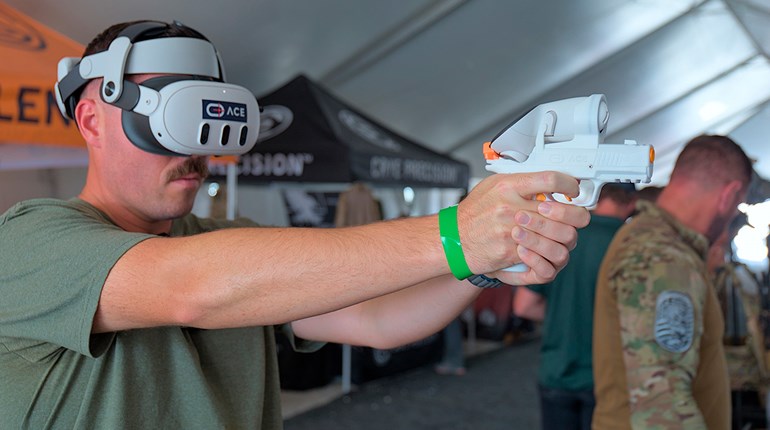
Practical
In practical competition, the shotgun boils down to one thing: loading. The shooter who does it the smoothest and fastest oftentimes wins the stage. The heavier the stage's round count, the more critical solid shotgun loading skills become. Here's a drill the pros practice to get themselves ready for a match.
When using a shotgun with an eight-round tube, start with two rounds in the gun: one in the pipe and one in the tube. At the start signal, engage one target, and then begin covering ground to the next target. While moving, load eight rounds into the gun.
For most competitors, this drill requires going to their belt caddy two times—grabbing four rounds at a time. Remember, this isn't a tactical drill, so you don't have to keep your eyes downrange. Find the caddie on your belt, and watch those rounds as they are fed into the gun.
"You already know what your footing is going to be," said champion 3-gunner Bruce Piatt. "The details of the loading process are what makes you fast. Pay attention to how you get the shells each time."
Once all eight rounds are loaded into the tube, engage your second target. If using a standard timer, the time elapsed between the two shots will give you your loading time. Change the drill up by going left-to-right, then right-to-left, forward and even backward. Every type of movement will be thrown into a 3-gun stage at one point or another.
"In competition if you're feet are moving, you should be loading," Piatt said. "Keep it in multiples of what you can grab and load."
When moving in various directions, always know where downrange is, and never break the 180-degree line, which would flag other competitors behind you. Not only would it be extremely unsafe, it's an immediate disqualification from the match. So in practice, be conscious of where you're moving and where the gun has to be pointed—all while concentrating on making smooth, fast loads.
Load all eight and break the shots in 10 seconds and you've achieved a good benchmark time from which to begin. Do it as fast as Bruce Piatt and other top pros, and you're going to be down in the 5-second range or below—and that's smokin' fast.
Tactical
The two primary differences between a practical and tactical loading drill should focus on the use of cover and from where the ammo is pulled.
In the practical drill, cover is not sought, nor would it be in a normal match setting. Instead, competitors are free to load completely out in the open. In a tactical or home-defense training environment, that's, as they say, a non-starter.
To begin a basic tactical drill, set up a couple of barricades on the range. Instead of beginning with two rounds in the gun, load it patrol ready, with a full tube and the bolt closed on an empty chamber. At the start signal, from behind the first barricade, slice the pie and engage all targets, taking as many shots as necessary to deal with any and all visible threats. Then seek cover again.
It's here where, in practice, trainers often teach students to replace what they have shot. Keeping you shotgun topped up to capacity may be critical in a self-defense situation and that habit should be reinforced in your training. If three shots have been fired, load four (remember, the chamber was empty) before moving on.
During the loading process itself, in the practical drill, competitors most often pull shells from a belt caddy, which is not very applicable for duty work or home defense. Instead, your gun should be set up with a sidesaddle caddy, a SpeedFeed stock or even a slip-on shell holder of some type, since they are more likely to be what one would use in a force-on-force scenario. Practice with the gear your self-defense shotgun will be wearing if you have to use it.
Once the basics are down, this drill can become extremely dynamic. You can change the variables to suit any type of threat: outside the home, inside the home, low-light, etc. Because this is a defensive drill, whereas practical shooters have the luxury of looking at the belt and watching the load, defensive shotgunners must keep their eyes downrange looking for threats.
"You should be proficient enough to do it in the dark," said Piatt, who is also a New Jersey police officer with decades of experience training law enforcement personnel "Don't get engrossed by loading. No matter how long it takes, you still can't lose situational awareness."
When all rounds have been replaced, move to the next barricade and engage available targets. When finished, seek cover again and reload again as many shotshells as have been fired.
Whether for sport or defense, learning to smoothly and efficiently reload will have a dramatic impact on your shotgun performance. But to get there, it takes dedicated and continued practice, always with the goal of developing muscle memory and improving one's technique. Most importantly, according to Piatt, is training that loading technique into a rock-solid, reliable skill.
"Consistency is more important than outright speed," Piatt said.




































